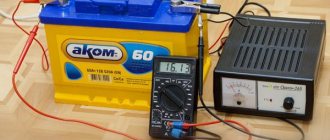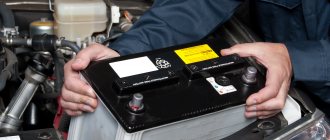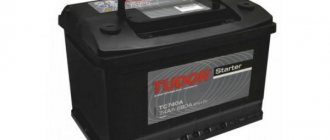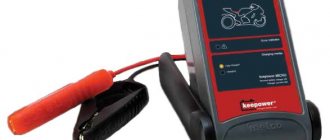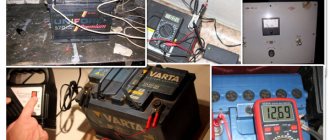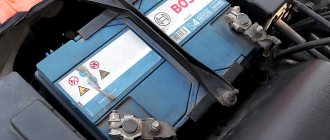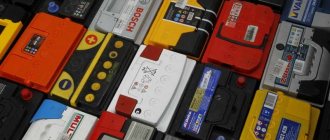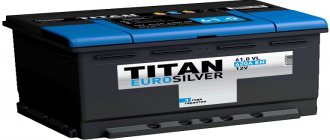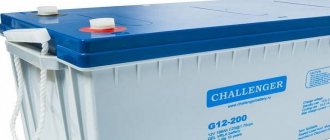Old-style car batteries are being replaced with sealed batteries. The user may not understand how to charge a maintenance-free battery. Car owners are also concerned about whether frequent recharging will affect the service life of the product.
Charging a maintenance-free battery.
Types of maintenance-free batteries
The following types of maintenance-free batteries exist:
- Lead-calcium-acid. The plates of this device are coated with calcium. They are resistant to corrosion and vibration. Calcium coating reduces the rate of electrolyte boiling and self-discharge.
- A.G.M. It is an acid battery in which the electrolyte is placed in special fiberglass separators. This type of power supply is insensitive to critical discharges. The plate sulfation rate is reduced, so the battery operates uninterruptedly for 10 years.
- EFB. A special feature of the structure of such a battery is the increased thickness of the electrodes made of lead. The use of material impregnated with an acidic composition helps reduce sulfation. They wrap the plates of the battery cans. The service life of the product is 7-10 years.
- GEL. The liquid filler in such batteries is replaced by gel filler.
Charging time calculation
If you work with automatic memories, you won’t have to calculate anything. The device will turn itself off when charging is complete.
But motorists are potentially interested in knowing how long it will take to charge. Here you need to proceed from how much capacity the battery has lost.
Let's assume that the voltage drops to 12.1 V. This corresponds to a 50% charge. Since a 50Ah battery needs to be charged for 10 hours at 5A per hour, it would only take 5 hours to recharge 50% of the capacity.
Why you need to charge maintenance-free batteries
It is necessary to charge the battery, especially during preparation for winter. Despite the long service life, the capacity of the power supply decreases over time. Other reasons for needing to recharge include:
- Lack of energy at startup. A battery charged from a generator may not produce enough current to start the engine. This happens if the car is used to travel short distances. This time is not enough to restore the battery's energy potential. In this case, the battery is periodically connected to the charger.
- Loss of charge in frosty weather. To start the engine at negative temperatures, a higher starting current is required. At the end of autumn, you need to fully restore the charge of a maintenance-free car battery. The maximum capacity provides enough energy to start the engine in cold weather.
How to determine charging duration
If you use a device with an ammeter as an indication, then you need to determine the charging process . The most common batteries have a capacity of 55-62 A/h. Taking the middle, the total capacity will be 60 A/h. Considering that half of the charging is done while driving the car, its capacity will be 30 A/h.
The required current for such a capacity is 6 A. This means that the required time is calculated by the formula:
T=30/6=5 hours.
Charging process
DC charging is used to restore the energy potential of a critically discharged battery. The process lasts several days and requires constant monitoring. The battery restores its capacity as much as possible. The procedure includes the following steps:
- At this stage, the current strength is established. It should be 10% of the Varta battery capacity. For a battery with a capacity of 80 Ampere/hour, a current of 8 A is selected. Charging continues until the voltage at the battery terminals reaches 14.4 V. Chargers with built-in regulators help select the desired Volt and Ampere values.
- At this stage, the voltage increases and the electrolyte boils. Reducing the current intensity by 2 times helps reduce the intensity of gas formation. The charging process continues.
- After increasing the voltage at the terminals to 15 V, the current is again reduced by 2 times. The process of restoring the power of the car's battery continues. The user periodically measures the current and voltage. If the parameters remain unchanged, the battery is considered fully charged.
Applying constant voltage to the terminals allows you to properly charge a maintenance-free battery that has partially lost its charge. When the current drops to 200 mA, the charger will stop working. This operating principle is typical for most automatic low-cost chargers.
When a voltage of 14.4 V is applied, the battery will be charged to 80% within 24 hours. 100% restoration of energy potential during a 24-hour procedure is ensured by starting a current of 16 V.
Which charger to charge with?
The optimal device for charging maintenance-free batteries should be automatic. Below is a rating of the five most popular memory devices in Russia:
- Smart Power SP-8N. Belongs to the category of semi-professional devices. Used to restore the performance of any type of battery with a capacity of 4–160 A/h. Charging a maintenance-free car battery with a Smart Power charger occurs in 9 cycles; there is a desulfation mode.
- Orion Pennant 57. Charging, which also performs a pre-launch function. The current adjustment range is 0.8–20 A, voltage – 7.4–18 V. The permissible battery capacity is 200 A/h. There is protection against short circuit and polarity reversal.
- STACK MXS 3.8. Automatic charging in 7 cycles. The case is protected from overheating, moisture, and dust. Charging current – up to 3.8 A, battery capacity – up to 130 A/h. You can select the charging mode. How to charge a maintenance-free battery using CTEK? Just plug it into a socket and connect the probes.
- Quattro Elementi-Charge 10. Full automatic with display. Maximum charge current is 10 A, battery capacity is 100 A/h. All types of protection: electronic against short circuit, conventional - against overheating of the case, moisture and dirt getting inside.
Knowing how to charge a maintenance-free battery with a charger will significantly increase its service life. This will save you from unnecessary financial expenses, and you will be confident in your current source when traveling over any distance and in any conditions.
Nuances when charging a maintenance-free car battery
When restoring the capacity of Varta power supplies or any other maintenance-free batteries, the following nuances are taken into account:
- It is impossible to measure the density of the electrolyte in the battery.
- The sealed case does not allow charging the battery with high current.
- The power source is charged by placing it on a flat surface. This helps prevent the body from tipping over during the procedure.
- Before applying current, the residual voltage is measured. A battery that has lost its charge must be charged with a stable voltage. The current on the charger needs to be adjusted. The voltage supplied to the terminals should be 14-14.5 V. The recommended starting current is 2 A.
- When using non-automatic chargers, the charging process is controlled. When the charge power decreases to 0.2 A, the device is turned off.
- It is impossible to supply a current of more than 15 A. It is not recommended to allow the voltage to increase to 15.5 V.
- A deeply discharged battery must be charged for at least 24 hours.
- Do not allow the electrolyte to boil for a long time. The release of large amounts of gases leads to an explosion or fire. If bubbling occurs, stop charging immediately. You cannot fill a maintenance-free battery with water.
- Before charging begins, the battery is removed. The user must have access to a power source. This makes it possible to quickly de-energize. If charge restoration is carried out without dismantling, you need to disconnect the vehicle's on-board network from the battery.
- Charging is carried out in a heated room. It is not recommended to connect the charger outdoors.
Checking parameters while charging.
Advantages and disadvantages
To take an objective look at maintenance-free car batteries, it is worth studying their advantages and disadvantages.
Everyone knows and can imagine classic batteries with liquid electrolyte and plugs for access to the banks. When working with them, drivers have to check the electrolyte level and measure its density. It is also necessary to add distilled water; less often, a fresh portion of the finished electrolyte is added.
The downside here is that it was quite easy to get burned by acid if you did not follow basic safety precautions.
It would seem that, looking at maintenance-free batteries and studying their advantages and disadvantages, the strengths should significantly outweigh the weaknesses.
Maintenance-free batteries are batteries that do not have access to banks (sections) in the form of special covers. Their body is completely sealed.
This makes it clear what a maintenance-free car battery means. But it is not entirely clear what its advantages and disadvantages are.
The advantages include the following factors:
- long-term retention of accumulated charge;
- improved plates;
- sealed housing;
- the presence of special valves to relieve excess pressure;
- minimal volatility of the working fluid;
- increased service life;
- adaptability to the requirements of modern cars.
It cannot be said that the service life of the maintenance-free battery in question will be significantly longer than that of an open-type car battery. It all depends on the quality of the battery, as well as on compliance with the rules of operation and maintenance.
Although design features and the almost complete absence of water evaporation allow manufacturers to set a longer service life indicated on the body.
It is difficult to single out any obvious shortcomings here. The fact that banks cannot be accessed is very controversial. This is often simply not necessary. There is no need to add water. Some people open the case and then restore it by soldering. But this is an extreme measure and is not recommended.
The cost can also be considered a disadvantage. For objective reasons, maintenance-free batteries are more expensive than their serviced counterparts. But again, the price increase is due to the corresponding advantages and superiority of the new technology.
Everyone can now draw their own conclusions and decide whether it is worth switching to maintenance-free batteries, or remaining faithful to the good old serviced batteries.
Charging at home
It is dangerous to charge batteries of the serviced type at home. When the electrolyte boils, toxic and explosive gases are released. Charging maintenance-free batteries does not pose a danger to humans. According to the instructions, the battery is placed away from heat sources in a ventilated area. Charge the power source by applying a voltage of 14 V. After 15 hours, the parameter is reduced to 13.2 V.
If you don't have a charger, you can assemble it yourself. A resistor that regulates the voltage must be included in the circuit.
What are the disadvantages of a hydrometer?
To make life easier for motorists, manufacturers have provided a special charge sensor in maintenance-free batteries - the so-called hydrometer.
When the density increases (charging the battery), the indicator rises, and when it decreases (discharge), it goes down.
But such a hydrometer also has a number of disadvantages:
- firstly, it often shows incorrect data, which misleads car enthusiasts;
- secondly, the float is installed in only one jar, so you still have to keep the charging process under control;
- thirdly, charging information can be obtained when the capacity reaches 65%. During the subsequent charge (up to 100%), the position of the float does not change, so it is still impossible to accurately determine the charge level;
- fourthly, the indicator does not provide the necessary information if the electrolyte level has dropped to the point where the plates are exposed.
